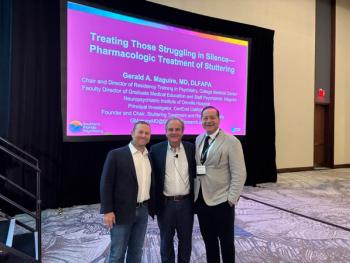
Neuropsychiatric Complications and Treatment Approaches Following Traumatic Brain Injury
Neuropsychiatric disorders regularly occur following traumatic brain injury and are often diagnosed within the first year postinjury. Diagnosis and treatment of neuropsychiatric disorders can be difficult due to a number of interacting factors, such as preinjury psychiatric history, lesion location, injury severity, substance misuse, and psychosocial complications. Clinicians should use a highly individualized approach to diagnosis and treatment planning.
Neuropsychiatric disorders regularly occur following traumatic brain injury (TBI) and are often diagnosed within the first year postinjury.1,2 The most commonly diagnosed DSM Axis I disorders include mood, anxiety, and
Psychosocial consequences of
Neuropsychiatric and psychosocial consequences of brain injury involve a number of variables. Injury severity and lesion location disrupt neural circuitry responsible for emotional control, self-awareness, and impulse control. Psychological or psychodynamic variables include resources, personal values, personal attitudes toward disability, and personality characteristics. These influence how an individual perceives the impact of injury, as well as personal resources to adapt and recover. Finally, psychosocial variables impact an individual’s ability to engage in social and productive activities, and use networks of social support.9,10 These variables can also create barriers to successful rehabilitation and community reintegration.
Dual Diagnosis
Dual diagnosis, also known as comorbidity or co-occurring disorder, refers to combinations of psychiatric disorders that co-occur in the same individual.11 Symptoms of co-occurring disorders can overlap and may worsen the course of both disorders. In the case of TBI and co-occurring neuropsychiatric disorders, it is sometimes difficult to determine if presenting symptoms are the direct result of injury to the brain, or an appropriate situational reaction to the injury.12 Many of the symptoms frequently reported following TBI, such as irritability, fatigue,
Frequency and Course of Neuropsychiatric Disorders Following TBI
The frequency of neuropsychiatric disorders reported following TBI varies greatly due to methodological differences in studies, including study design, subject recruitment, diagnostic and assessment techniques employed, heterogeneous etiologies of injury and injury severity, and length of time postinjury when diagnoses are made.3,17-19 Prospective studies, systematic reviews of the literature, and studies using the gold standard Structured Clinical Interview for DSM (SCID) to diagnose neuropsychiatric disorders following TBI can be summarized as follows:
- A significant percentage of individuals with TBI had a preinjury diagnosis of a psychiatric disorder. Gould and colleagues17 assessed adults with predominately moderate-to-severe TBI for a preinjury psychiatric disorder and followed the cohort (N=102) for 12 months postinjury. Neuropsychiatric disorder was diagnosed using the SCID. Over half of the participants had a preinjury SUD, mood disorder, or anxiety disorder. In a retrospective study of 100 participants with mild to severe TBI using the SCID to diagnose psychiatric disorder pre- and postinjury, Wehlan-Goodinson and colleagues18 found that 52% of the sample received a psychiatric diagnosis preinjury.
- Neuropsychiatric disorders are common after TBI, with the majority developing within the first year of injury. Gould reported that 60.8% of the study sample received a neuropsychiatric diagnosis, predominately mood and anxiety disorders within the first year postinjury.19 Alway and colleagues followed a cohort of adults with moderate-to-severe TBI for 5 years.1 Psychiatric disorders were diagnosed using the SCID, and 75.2% of their sample received a neuropsychiatric diagnosis during the follow-up period, with the majority of disorders emerging in the first year of injury.
- While significant numbers of individuals with TBI had a preexisting psychiatric disorder, many new or novel neuropsychiatric disorders are diagnosed postinjury. Alway found that 45.8% of the study cohort developed new or novel neuropsychiatric disorder1; Gould reported 56.5% of subjects in the cohort developed a new disorder not present prior to injury.19
- The timing of the emergence of neuropsychiatric disorders differs depending upon the presence or absence of a preexisting psychiatric disorder. Individuals with a preexisting psychiatric disorder often have a post-TBI neuropsychiatric disorder diagnosed upon initial assessment, or within the first 6 months of injury. However, individuals with no prior psychiatric history often develop a novel neuropsychiatric disorder later in the first year following injury.3,19
- Some neuropsychiatric disorders may decline over time, while others remain stable. Alway found that anxiety disorders declined significantly over time, while mood and SUDs remained stable.1 Whelan-Goodinson also reported a decline in SUD with few novel cases.18
- Neuropsychiatric disorders following TBI tend to co-occur. Alway found that anxiety and SUD co-occur.1 Anxiety and depressive disorders also tend to co-occur following TBI.3,18,19 Injury severity may be a factor as rates of neuropsychiatric disorder tend to decline over time for moderate-to-severe brain injuries, but may increase over time for mild TBI.
Diagnosis and Treatment Considerations
There are a number of interacting factors, such as preinjury psychiatric history, lesion location, injury severity, substance misuse, and psychosocial complications, that make it difficult to categorize patients for the purposes of neuropsychiatric diagnosis and treatment. For this reason, a highly individualized approach to diagnosis and treatment planning is recommended.14,16 Arciniegas and colleagues14 recommend that assessment should include a thorough developmental, psychiatric and medication history, along with a current mental status and neurological examination. Neuropsychiatric symptoms should be quantified using standardized scales and inventories, and should be evaluated in the context of the patient’s premorbid history and current circumstances. Given that a large number of patients present with a mood disorder postinjury, mood stabilization should be a treatment priority.16 When medications are prescribed, Arciniegas14 recommends a conservative approach to because patients with TBI may be particularly sensitive and susceptible to medication adverse effects. Frequent monitoring is recommended for effectiveness, adverse effects, and drug interactions. Avoid medications with sedative properties. When possible, psychotherapy should accompany a medication regimen when treating neuropsychiatric disorders postinjury.14 Behavioral therapies based on the principles of classical and operant conditioning have been used to successfully manage behavioral dysregulation following traumatic brain injury. Cognitive behavior therapy (CBT) has been shown to reduce psychosocial distress by helping patients modify underlying thinking patterns and maladaptive automatic thoughts.20 Cognitive impairments frequently accompany TBI and modifications to traditional CBT interventions, such as providing written materials, summarizing information, and repeating key learning points, have proven beneficial.21 Pilot projects with small samples and single case studies using Acceptance and Commitment therapy have shown promise in reducing symptoms of depression and anxiety following TBI.22 Therapeutic interventions that address trauma, such as EMDR, have been shown to reduce symptoms of anxiety and posttraumatic stress disorder following TBI.23
Dr Seale is the regional director of clinical services at the Centre for Neuro Skills, which operates post-acute brain injury rehabilitation programs in California and Texas. He is licensed in Texas as a chemical dependency counselor and psychological associate with independent practice. He also holds a clinical appointment at the University of Texas Medical Branch (UTMB) in Galveston in the Department of Rehabilitation Sciences.
References
1. Alway Y, Gould KR, Johnston, L, et al.
2. van Reekum R, Cohen T, Wong J.
3. Ponsford J, Always Y, Gould KR.
4. Oddy M. Psychosocial consequences of brain injury. In: Greenwood RJ, McMillan TM, Barnesx MP, Ward CD, eds. Handbook of Neurological Rehabilitation. Psychology Press; 2005:469-478.
5. Mundluru J, Subhan A, Lo TWB, et al.
6. Ciurli P, Formisano R, Bivona U, et al.
7. Humphreys I, Wood RL, Phillips CJ, Macey S.
8. Scholten AC, Haagsma JA, Cnossen MC, et al.
9. Pepping M, Roueche JR. Psychosocial consequences of significant brain injury. In: Tupper DE, Cicerone KD, eds. The Neuropsychology of Everyday Life: Issues in Development and Rehabilitation. Kluwer Academic Publishers; 1991.
10. Gainotti G.
11. Bennett ME, Gjonbalaj-Morovics. The problem of dual diagnosis. In: Beidel DC, Frueh C Adult Psychopathology and Diagnosis, Eighth Edition. Wiley; 2018.
12. Kim E, Lauterbach EC, Reeve A, et al.
13. Morton MV, Wehman P.
14. Arciniegas DB, Topkoff J, Silver JM.
15. Albrecht JS, Abariga SA, Rao V, Wickwire EM.
16. Lauterbach MD, Notarangelo PL, Nichols SJ, et al.
17. Diaz AP, Schwarzbold ML, Thais ME, et al.
18. Whelan-Goodinson R, Ponsford J, Johnston L, Grant F.
19. Gould KR, Ponsford J, Johnston L, Schönberger M.
20. Little A, Byrne C, Coetzer R.
21. Anson K, Ponsford J.
22. Kangas M, McDonald S.
23. Janssen EPJ, Spauwen PJJ, Rijnen SJM, Ponds RWHm.
Newsletter
Receive trusted psychiatric news, expert analysis, and clinical insights — subscribe today to support your practice and your patients.














